Modernize your crisis hotline with Twilio Flex
Time to read: 7 minutes
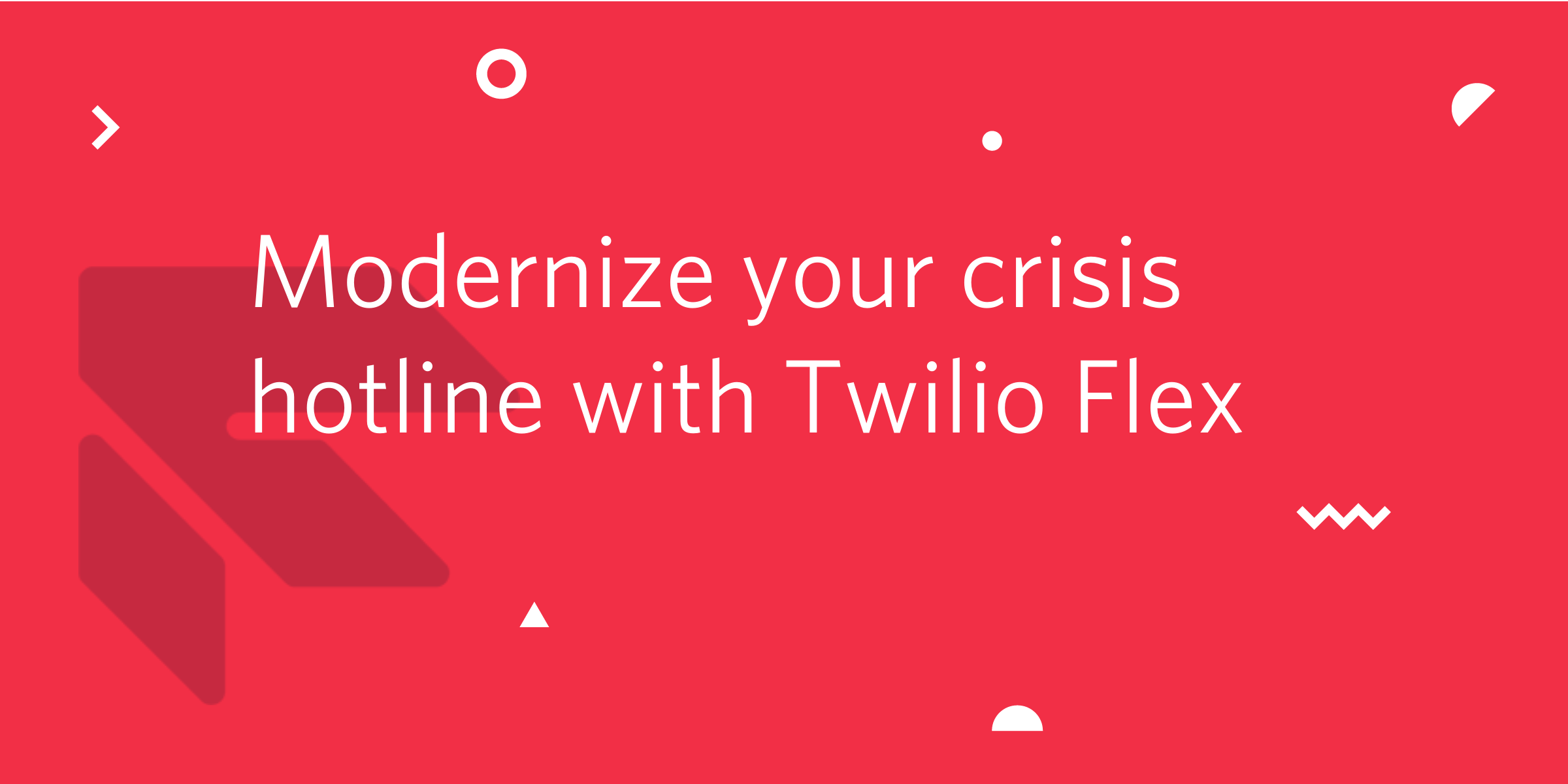
Every day, hundreds of thousands of people turn to crisis hotlines for support during some of the hardest moments of their lives. With suicide rates in the U.S. at their highest since WWII, and so many Americans succumbing to "deaths of dispair" (drug overdose, alcohol-related illness, and suicide) that life expectancy has decreased the past 3 years — demand for these life saving intervention services is increasing. In fact, calls to the National Suicide Lifeline Network have more than doubled since 2014 — with that number expected to climb even more significantly once the new 3-digit suicide hotline number (988) is rolled out nationwide.
This growth in demand is making it increasingly challenging for already resource-constrained crisis centers to provide help to everyone who so desperately needs it. Unfortunately, many people in crisis today abandon their call after experiencing long wait times or simply never reach out in the first place. Now more than ever, it’s imperative that nonprofits who operate hotlines not only have the proper funding — but also the right tools and technologies to serve communities in crisis at the scale that aligns with the magnitude of the problem.
As part of Twilio.org’s Crisis Response & Prevention Initiative, we’re committed to supporting the thousands of nonprofit organizations who save lives through these crucial services each and every day. This article shares some of the many ways Flex, Twilio’s contact center platform, is being used to modernize crisis hotlines — empowering nonprofits increase their capacity while preserving a high quality of care. This post will outline 4 ways Flex can help you achieve your organization's mission:
- Multichannel options help you reach people where they feel most safe
- Full customizability empowers you to mold Flex to a hotline’s unique needs
- Powerful reporting and analytics help make sure someone is always there to listen
- Supervisor tools increase the likelihood of a successful intervention
Multichannel options help you reach people where they feel most safe
Research suggests that young people would rather go without help entirely than talk over the phone. Not only are text-based communications now a primary way we interact with one another, they can also offer increased anonymity to people who wouldn’t otherwise be able to talk about deeply personal issues.
And while crisis hotlines have traditionally been voice-only, the lack of availability of text-based crisis intervention can leave out large swaths of the community who would benefit from these services. Incorporating newly ubiquitous channels of communication like SMS and WhatsApp are proving to be essential to serving more people in crisis by allowing them to reach out in the way they feel most comfortable.
For instance, the International Rescue Committee’s (IRC) Signpost initiative connects people affected by gang violence in El Salvador with local moderators to provide individualized support and referrals to local services like shelters and legal assistance. After a needs assessment, the IRC has decided to enable WhatsApp — overwhelmingly the most popular communications medium in the country — as the main channel to connect with a moderator via Flex. This allows the organization to meet people where they are and drastically lowers the barrier for crisis-affected people to access the help they need.
WhatsApp is just one channel that Flex has to offer, in addition to voice, SMS, web chat, and more. With many options, you can enable the channels to best reach the communities that you serve. A suicide hotline in the U.S., for example, could enable voice, SMS, and web chat to allow people to choose how they wish to speak with a crisis counselor:
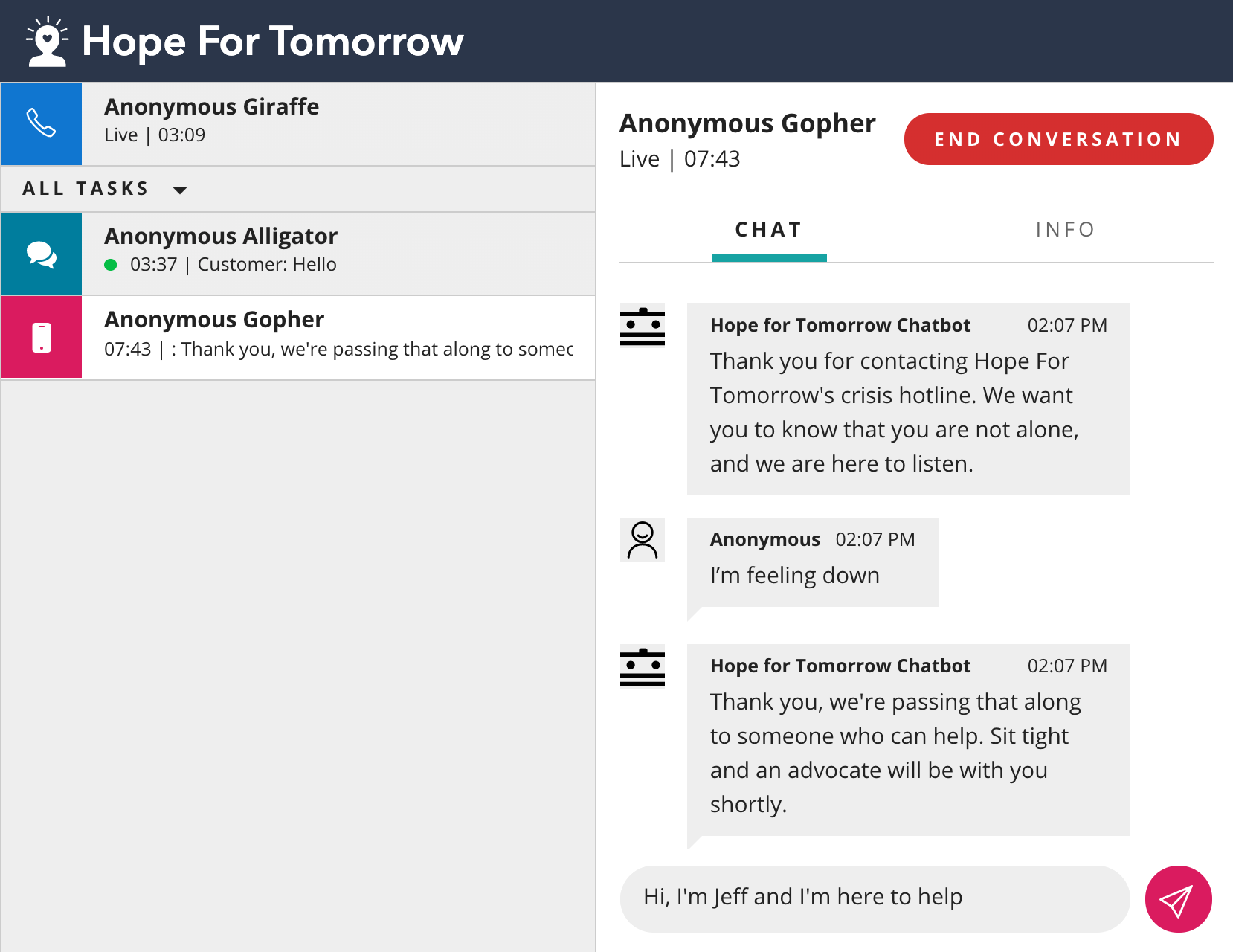
The omnichannel approach creates efficiencies for the hotline, too. While most crisis centers require hotline staff to use separate applications for each channel they support, Flex allows supervisors to see conversations across channels in one user interface. In addition, Flex allows counselors handling text-based conversations via SMS, WhatsApp or webchat to speak with more than one person at a time if they feel comfortable. This approach can help you reduce wait times.
To strike the right balance between serving more people and providing quality care, Flex gives you the ability to set caps on the number of concurrent conversations your staff can have. To further ease the wait, you can also configure automatic notifications for people in the queue to make sure they know that help is on the way.
Full customizability lets you mold Flex to a hotline’s unique needs
Instead of wedging your hotline into a product built for a business, you can tailor Flex to work exactly the way your nonprofit organization needs it to function. From the channels of communication you enable, to the case management system you embed, to how you present information — it’s all fully customizable with Flex.
For instance, many hotlines have strict requirements around protecting the identities of the people who reach out for help. As an example, RAINN’s National Sexual Assault Hotline avoids any collection and storage of personally identifiable information (PII) about a survivor to ensure their safety. This is because the communications of a sexual assault survivor may be monitored, so any record of the conversation creates risk for that person.
Flex can be configured to remove all PII for any crisis line:
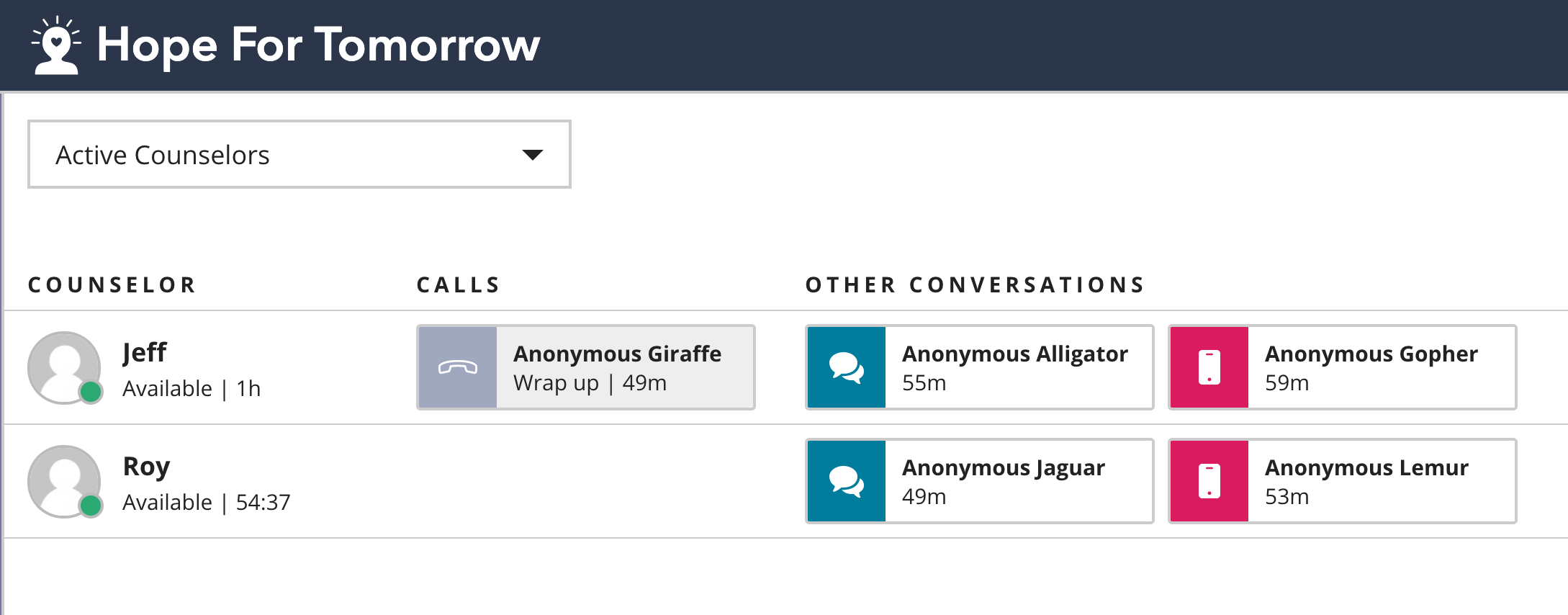
What’s more, you have the ability to determine how long call and message logs should be saved — with the option to delete them at any time or cadence. This helps you balance the need for understanding helpful information about those who contact you (in case someone contacts you multiple times in a short period), while still upholding your policies of confidentiality or anonymity.
Another way Flex can be customized to meet your unique needs is through its CRM integration capabilities. Your organization may already be using a system of record like iCarol that is used for case management, referrals, and conversation intake forms. With Flex, you can seamlessly integrate any system of record like iCarol directly into the contact center interface:
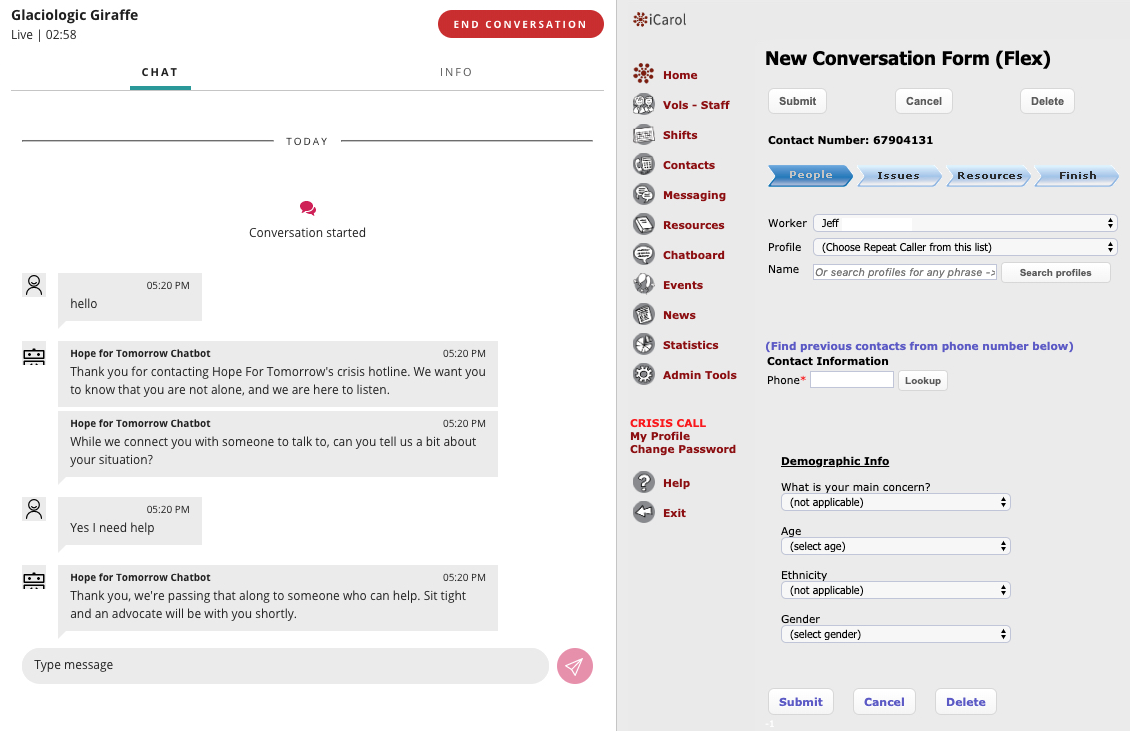
These systems enable crisis staff to document conversations, guide them through an approved intervention sequence, as well as make referrals to local service providers. Instead of needing to leave the context of the conversation to perform these actions, counselors can stay focused with a unified experience.
If your organization has developers, they can use our Flex APIs to completely customize the crisis hotline user interface based on your needs. For those organizations without many IT resources, we can put you in touch with integration partners who can help.
Powerful reporting and analytics help make sure someone is always there to listen
Many hotlines have targets for wait times, abandonment rates, and more to preserve a high quality of care. Understanding performance against these targets have massive implications on whether your organization is successfully serving those reaching out for help. In addition, most organizations operating a hotline are required to gather and regularly report these metrics to funders, national centers, and other governing bodies to prove the viability of their services.
Flex Insights provides your organization with dashboards that track these important metrics over time. For instance, this Hotline Performance dashboard aggregates data on average wait time, abandon rate, and average conversation time:
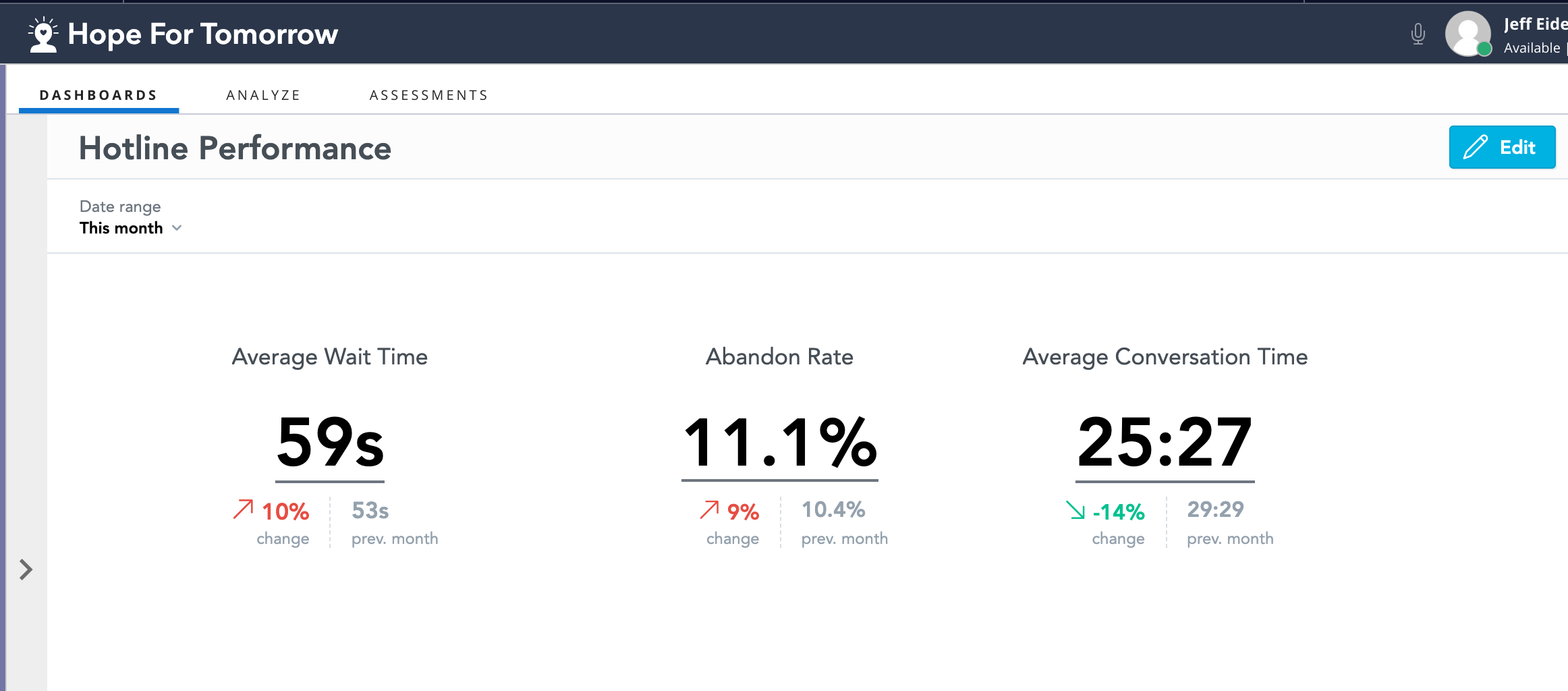
These three metrics are critical for any crisis center to understand quality of service and are commonly tracked by hotlines to measure efficacy. Of course, it is desirable to minimize the average wait time and abandonment rate. However, what is considered an optimal conversation time for hotlines is often higher than for a traditional commercial contact center and likely varies from organization to organization. These dashboards can be customized to display the data that is most relevant to your hotline, and are accessible at any time — no more waiting until the end of the month to understand your hotline’s traffic.
This information is not only important to have as a look-back, but arguably more valuable to react to in real-time. Flex Insights also allows the opportunity to set alerts on a metric that leaves a healthy threshold. For instance, we can set an alert if abandonment rate gets too high:
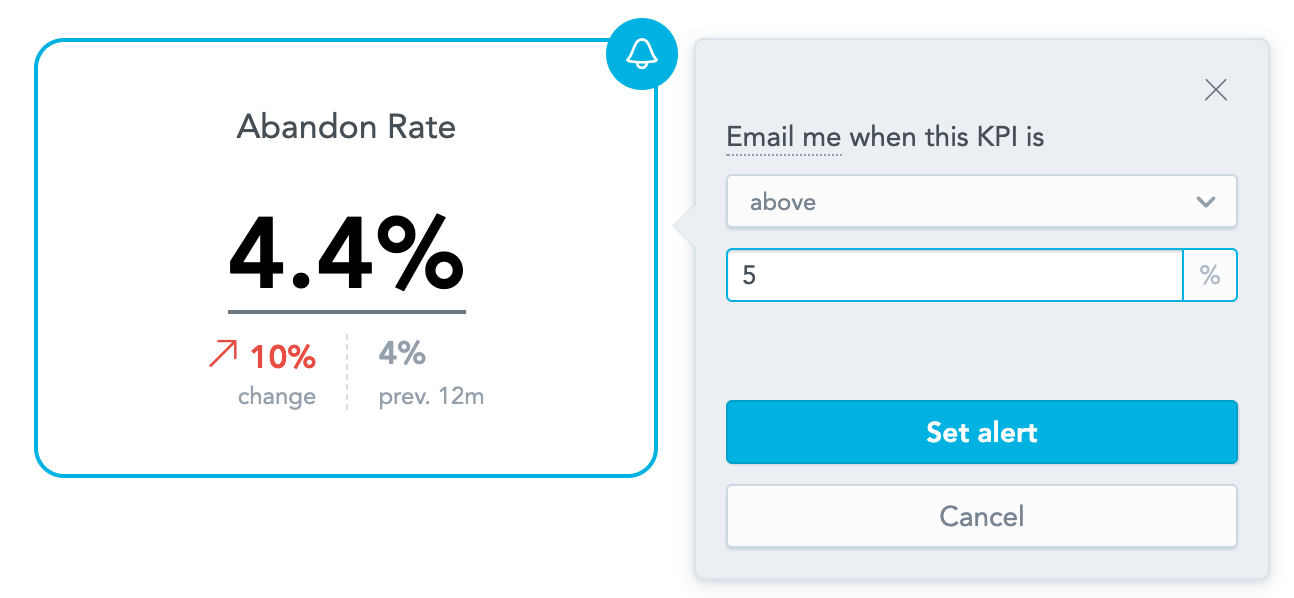
A hotline experiencing an unusual spike in volume would trigger this alert once too many people were dropping off. A large spike like this can happen, for instance, in the aftermath of a celebrity suicide. A notification like this could prompt a supervisor to reach out to offline counselors asking them to sign on and help shoulder the load. This ability to respond to what’s happening right now creates big opportunities to increase the operating efficiency of your hotline without sacrificing effectiveness.
Supervisor tools increase the likelihood of successful interventions
Many crisis centers have supervisors to oversee a group of crisis counselors as they are having conversations. Flex’s Teams View provides a bird’s eye view of all the counselors who are currently online, and what conversations they are engaged in.
In certain cases — for instance when a new counselor is being trained — it can be helpful for the supervisor to have visibility into active conversations. This view allows team members with supervisor-level access the ability to see transcripts of text-based conversations, or listen in on a phone call:
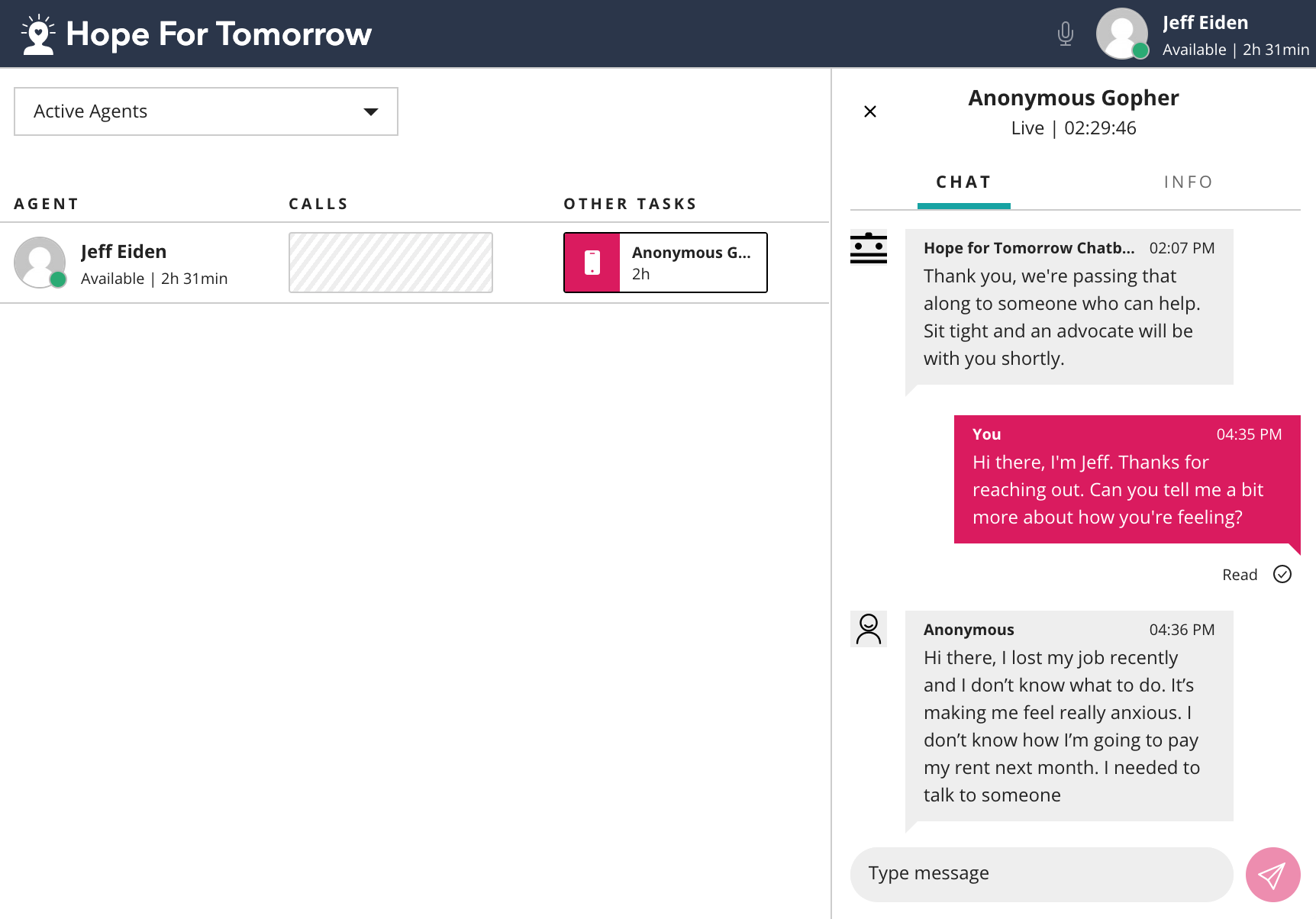
This tool empowers trusted supervisors and administrators to ensure high levels of quality. This means more conversations result in a successful intervention, and crisis counselors get the coaching they need to be effective in their work.
Save more lives with increased hotline capacity
Now more than ever, it’s imperative that nonprofits operating crisis hotlines take advantage of technologies that can help them serve more people, reduce response times, and improve quality of care. We’ve demonstrated just a small subset of all the ways Twilio Flex can empower your organization to achieve its mission. Our goal at Twilio.org is to support this important work — that’s why as an Impact Access member, nonprofits can qualify for significant discounts on Flex as well as many other Twilio products.
Ready to explore how Flex can power your hotline?
See how Flex can be tailored for crisis hotlines and consult with the Twilio team.
Sign up for Twilio.org's Impact Access Program!
Unlock $500 in kickstart credit and exclusive discounts on Twilio products only available to social impact organizations.
Related Posts
Related Resources
Twilio Docs
From APIs to SDKs to sample apps
API reference documentation, SDKs, helper libraries, quickstarts, and tutorials for your language and platform.
Resource Center
The latest ebooks, industry reports, and webinars
Learn from customer engagement experts to improve your own communication.
Ahoy
Twilio's developer community hub
Best practices, code samples, and inspiration to build communications and digital engagement experiences.


